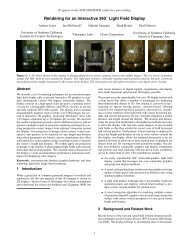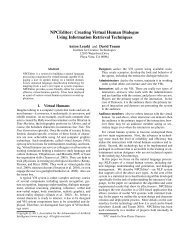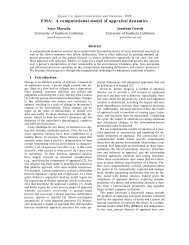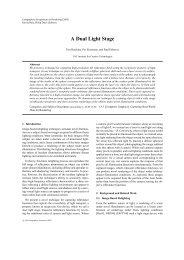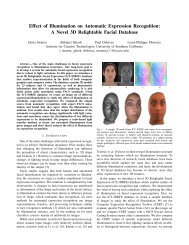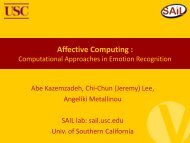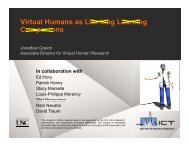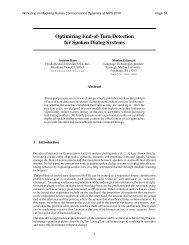Modeling appraisal in theory of mind reasoning - Institute for ...
Modeling appraisal in theory of mind reasoning - Institute for ...
Modeling appraisal in theory of mind reasoning - Institute for ...
- No tags were found...
You also want an ePaper? Increase the reach of your titles
YUMPU automatically turns print PDFs into web optimized ePapers that Google loves.
Auton Agent Multi-Agent Syst4.1.1 StateState conta<strong>in</strong>s <strong>in</strong><strong>for</strong>mation about an agent’s current status <strong>in</strong> the world. An agent’s state isdef<strong>in</strong>ed by a set <strong>of</strong> state features, such as the name and age <strong>of</strong> the character, and the relationbetween that character and other characters (e.g. aff<strong>in</strong>ity). Values <strong>of</strong> state features arerepresented as real numbers.4.1.2 DynamicsDynamics def<strong>in</strong>e how actions affect agents’ states. For example, we can specify that smalltalk among a group <strong>of</strong> agents will <strong>in</strong>crease their aff<strong>in</strong>ity with each other by 0.1. The effects<strong>of</strong> actions can be def<strong>in</strong>ed with probabilities. For example, the author may def<strong>in</strong>e that whenthe hunter tries to kill the wolf, the wolf will die only 60% <strong>of</strong> the time.4.1.3 GoalsWe model a character’s motivation and personality pr<strong>of</strong>ile as a set <strong>of</strong> goals and their relativeimportance (weight). Goals are expressed as a reward function over the various state featuresan agent seeks to maximize or m<strong>in</strong>imize. For example, a character can have a goal <strong>of</strong> maximiz<strong>in</strong>gits aff<strong>in</strong>ity with another character. The <strong>in</strong>itial value <strong>of</strong> this state feature can be anyvalue between 0.0 and 1.0; this goal is completely satisfied once the value reaches 1.0. Anagent usually has multiple goals with different relative importance (weights). For example,the character may have another goal <strong>of</strong> know<strong>in</strong>g another character’s name, and this goal maybe twice as important to the character as the goal <strong>of</strong> maximiz<strong>in</strong>g aff<strong>in</strong>ity. At any moment <strong>of</strong>time, an agent’s utility is simply calculated as State × Goals.4.1.4 Beliefs (<strong>theory</strong> <strong>of</strong> m<strong>in</strong>d)Thespian agents have a “<strong>theory</strong> <strong>of</strong> m<strong>in</strong>d”. The agent’s subjective view <strong>of</strong> the world <strong>in</strong>cludesits beliefs about itself and other agents and their subjective views <strong>of</strong> the world, a <strong>for</strong>m <strong>of</strong>recursive agent model<strong>in</strong>g. An agent’s subjective view (mental model) <strong>of</strong> itself or anotheragent <strong>in</strong>cludes every component <strong>of</strong> that agent, such as state, beliefs, policy, etc.Each agent has a mental model <strong>of</strong> self and one or more mental models <strong>of</strong> other agents.The agent’s belief about another agent is a probability distribution over alternative mentalmodels. For example, <strong>in</strong> the Red Rid<strong>in</strong>g Hood story, Red can have two mental models <strong>of</strong> thewolf—one be<strong>in</strong>g that the wolf does not have a goal <strong>of</strong> eat<strong>in</strong>g people and one be<strong>in</strong>g otherwise.Initially, Red may believe that there is a 90% chance the first mental model is true and a 10%chance the second mental model is true. This probability distribution will change if Red seesor hears about the wolf eat<strong>in</strong>g people.With<strong>in</strong> each mental model, an agent’s belief about its own or another agent’s state isrepresented as a set <strong>of</strong> real values with probability distributions. The probability distribution<strong>of</strong> the possible values <strong>of</strong> state features <strong>in</strong>dicates the character’s beliefs about these values.For example, a character’s belief about the amount <strong>of</strong> money another character has could be{8 with probability <strong>of</strong> 90%, 0 with probability <strong>of</strong> 10%}. 1 When reason<strong>in</strong>g about utilities <strong>of</strong>actions,∑the expected value <strong>of</strong> a state feature is normally used, which is simply calculated asni= 0 value i × P(value i ). For the simplicity <strong>of</strong> demonstration, <strong>in</strong> this paper we only giveexamples us<strong>in</strong>g the expected values.1 This example only <strong>in</strong>cludes one state feature <strong>for</strong> the simplicity <strong>of</strong> demonstration. In general, the probabilitydistribution is associated with the values <strong>of</strong> all state features.123
Auton Agent Multi-Agent SystFig. 1 Belief revision and decision-mak<strong>in</strong>g Processes4.1.5 PolicyPolicy <strong>in</strong><strong>for</strong>ms the agent <strong>of</strong> its best action given the current status <strong>of</strong> the world—the agent’sbelief about its own state and other agents’ states. By default, all agents use a bounded lookaheadpolicy to automatically decide their choice <strong>of</strong> actions dur<strong>in</strong>g an <strong>in</strong>teraction. The agentsproject <strong>in</strong>to the future to evaluate the effect <strong>of</strong> each candidate actions, and choose the onewith the highest expected utility (see Sect. 4.2.2 <strong>for</strong> details).4.1.6 Social relationshipsThespian has a built-<strong>in</strong> capability <strong>of</strong> model<strong>in</strong>g static and dynamic social relationships betweenagents which <strong>in</strong> turn can <strong>in</strong>fluence the agent’s decision-mak<strong>in</strong>g and belief update. Specifically,Thespian agents ma<strong>in</strong>ta<strong>in</strong> a measure <strong>of</strong> support/aff<strong>in</strong>ity <strong>for</strong> another agent. Support iscomputed as a runn<strong>in</strong>g history <strong>of</strong> their past <strong>in</strong>teractions. An agent <strong>in</strong>creases/decreases itssupport <strong>for</strong> another, when the latter selects an action that has a high/low reward, with respectto the preferences <strong>of</strong> the <strong>for</strong>mer.4.2 Belief revision and decision-mak<strong>in</strong>g processesUpon observation <strong>of</strong> an event, each agent updates its beliefs based on the observation and itsexpectations, and then makes decisions on its next action based on the updated beliefs. Thedecision-mak<strong>in</strong>g process also generates new expectations <strong>for</strong> future events and related selfand other agents’ states and utilities. These expectations will be used <strong>for</strong> the follow<strong>in</strong>g beliefupdate. Figure 1 illustrates this process.4.2.1 Belief revision processesAn agent’s beliefs get updated <strong>in</strong> two ways. One is through dynamics. Upon observation <strong>of</strong>an event, with<strong>in</strong> each mental model the agent has, the correspond<strong>in</strong>g dynamics are appliedand the related state features’ values are updated. The other way an agent changes its beliefsis through adjust<strong>in</strong>g the relative probabilities <strong>of</strong> alternative mental models. Each observationserves as an evidence <strong>for</strong> the plausibility <strong>of</strong> alternative mental models, i.e. how consistent theobservation is with the predictions from the mental models. Us<strong>in</strong>g this <strong>in</strong><strong>for</strong>mation, Bayes’Theorem is applied <strong>for</strong> updat<strong>in</strong>g the probabilities <strong>of</strong> alternative mental models [8]. Dur<strong>in</strong>gthis process, the predictions from alternative mental models are generated by the agent’spast decision-mak<strong>in</strong>g processes. A special case is when the agent only cares about its immediatereward: <strong>in</strong> this case it per<strong>for</strong>ms a zero step lookahead dur<strong>in</strong>g decision-mak<strong>in</strong>g andthere<strong>for</strong>e <strong>for</strong>ms no expectations about other’s future actions. If the agent needs to adjust the123
Auton Agent Multi-Agent SystFig. 2 Red’s lookahead processprobabilities associated with its alternative mental models <strong>of</strong> others, 2 expectations need tobe <strong>for</strong>med right be<strong>for</strong>e the agent’s belief revision.4.2.2 Decision-mak<strong>in</strong>g processIn Thespian, all agents use a bounded lookahead policy. When an agent has multiple mentalmodels <strong>of</strong> others, by default its next action is decided by lookahead reason<strong>in</strong>g us<strong>in</strong>g the mostprobable mental models, though the expected states/utilities <strong>of</strong> all alternative mental modelsare calculated <strong>for</strong> the purpose <strong>of</strong> belief revision.Each agent has a set <strong>of</strong> candidate actions to choose from when mak<strong>in</strong>g decisions. When anagent selects its next action, it projects <strong>in</strong>to the future to evaluate the effect <strong>of</strong> each option onthe state and belief <strong>of</strong> other entities <strong>in</strong> the story. The agent considers not just the immediateeffect, but also the expected responses <strong>of</strong> other characters and, <strong>in</strong> turn, the effects <strong>of</strong> thoseresponses, and its reaction to those responses and so on. The agent evaluates the overall effectwith respect to its goals and then chooses the action that has the highest expected value.Figure 2 lays out the expected states/utilities be<strong>in</strong>g calculated when a character per<strong>for</strong>msa one step lookahead with the belief that other characters will also per<strong>for</strong>m a one step lookahead.The actions <strong>in</strong> bold square are the actions with the highest expected utilities amongall options from the actor’s perspective. This lookahead is tak<strong>in</strong>g place <strong>in</strong> the character Red’sbelief space be<strong>for</strong>e she makes a decision. For each <strong>of</strong> her action options, she anticipates howthe action affects each character’s state and utility. For example, when Red decides her nextaction after be<strong>in</strong>g stopped by the wolf on her way to Granny’s house, the follow<strong>in</strong>g reason<strong>in</strong>ghappens <strong>in</strong> her “m<strong>in</strong>d” us<strong>in</strong>g her beliefs about the wolf and herself. For each <strong>of</strong> her actionoptions, e.g. talk<strong>in</strong>g to the wolf or walk<strong>in</strong>g away, she anticipates how the action directlyaffects each character’s state and utility. Next, Red considers the long term reward/punishment.For example, it may be fun to talk to the wolf <strong>for</strong> a little while (positive immediatereward), but this will delay Granny from gett<strong>in</strong>g the cake (long term punishment). To account<strong>for</strong> long term effects, she needs to predict other agents’ responses to her potential actions. Foreach <strong>of</strong> her possible action, Red simulates the wolf’s lookahead process. Similarly, <strong>for</strong> each2 It is <strong>of</strong>ten the case that if an agent only per<strong>for</strong>ms zero step lookahead <strong>for</strong> decision-mak<strong>in</strong>g, it does not careabout the probabilities <strong>of</strong> alternative mental models because the agent does not use the mental models <strong>in</strong> itsdecision-mak<strong>in</strong>g.123
Auton Agent Multi-Agent Syst<strong>of</strong> the wolf’s possible action choices, Red calculates the immediate expected states/utilities<strong>of</strong> both the wolf and herself. Next, Red simulates the wolf anticipat<strong>in</strong>g her responses. S<strong>in</strong>cethe lookahead process only simulates bounded rationality, this recursive reason<strong>in</strong>g wouldstop when the maximum number <strong>of</strong> steps <strong>for</strong> <strong>for</strong>ward projection is reached. For example,if the number <strong>of</strong> lookahead steps is set to be one, the wolf will pick the action with highestutility after simulat<strong>in</strong>g one step <strong>of</strong> Red’s response rather than several rounds <strong>of</strong> <strong>in</strong>teraction.Similarly based on the wolf’s potential responses <strong>in</strong> the next step, Red calculates the utilities<strong>of</strong> her action options—the sum <strong>of</strong> reward/punishment <strong>of</strong> the current and all future steps, andchooses the one with the highest utility. Theoretically, each agent can per<strong>for</strong>m lookahead <strong>for</strong>large enough number <strong>of</strong> steps until there is no ga<strong>in</strong> <strong>for</strong> itself and other agents. For per<strong>for</strong>mancereasons, we limit the projection to a f<strong>in</strong>ite horizon that we determ<strong>in</strong>e to be sufficientlyrealistic without <strong>in</strong>curr<strong>in</strong>g too much computational overhead. For example, three steps <strong>of</strong>lookahead is simulated <strong>for</strong> model<strong>in</strong>g characters <strong>in</strong> the Little Red Rid<strong>in</strong>g Hood story, and <strong>for</strong>model<strong>in</strong>g a negotiation scenario, which is not <strong>in</strong>cluded <strong>in</strong> this paper, we simulated up to eightsteps <strong>of</strong> lookahead.5 Computational model <strong>of</strong> <strong>appraisal</strong>In this section we illustrate how <strong>appraisal</strong> dimensions can be derived by leverag<strong>in</strong>g processes<strong>in</strong>volved and <strong>in</strong><strong>for</strong>mation gathered <strong>in</strong> an agent’s belief revision and decision-mak<strong>in</strong>g processes.We first describe when <strong>appraisal</strong> happens and where the related <strong>in</strong><strong>for</strong>mation comesfrom, and then present algorithms <strong>for</strong> evaluat<strong>in</strong>g each <strong>appraisal</strong> dimension.5.1 Overview <strong>of</strong> the modelWe model <strong>appraisal</strong> as a cont<strong>in</strong>uous process, that people constantly reevaluate their situationsand <strong>for</strong>m a “<strong>appraisal</strong>-cop<strong>in</strong>g-re<strong>appraisal</strong>” loop, as described <strong>in</strong> [32].Dur<strong>in</strong>g decision-mak<strong>in</strong>g, the lookahead process calculates the agent’s belief about whatwill happen <strong>in</strong> the future. This <strong>in</strong><strong>for</strong>mation will be kept <strong>in</strong> the agent’s memory as its expectations.The agent will not only keep expectations generated <strong>in</strong> its last lookahead process,but also those generated <strong>in</strong> its previous lookahead process, because the evaluations <strong>of</strong> some<strong>appraisal</strong> dimensions, e.g. accountability need to trace back more than one step. Note thatthese expectations not only conta<strong>in</strong> the agent’s expected actions <strong>of</strong> other agents and self <strong>in</strong>the future, but also the expected states/utilities <strong>of</strong> every possible action choices <strong>of</strong> each <strong>of</strong>the agents, as this <strong>in</strong><strong>for</strong>mation serves as the explanation <strong>for</strong> why the agent would make theexpected choice.Upon observ<strong>in</strong>g a new event—an action per<strong>for</strong>med by an agent or the human user, eachagent updates its beliefs and appraises the situation. The calculation <strong>of</strong> motivational relevance,motivational congruence, novelty and accountability depends only on the agent’sbeliefs about other agents’ and its own utilities <strong>in</strong> the current step and the previous steps, andthere<strong>for</strong>e can be derived immediately (see Sect. 5.2 <strong>for</strong> details). Depend<strong>in</strong>g on the extent <strong>of</strong>reason<strong>in</strong>g the agent per<strong>for</strong>med <strong>in</strong> the <strong>for</strong>mer steps, the agent may or may not have <strong>in</strong><strong>for</strong>mationimmediately available regard<strong>in</strong>g its control <strong>of</strong> the situation. However, when the agent makesits next decision, control will be automatically evaluated and this evaluation will affect theagent’s emotion. In fact, at this time the agent may reevaluate along every <strong>appraisal</strong> dimensionas it obta<strong>in</strong>s more updated <strong>in</strong><strong>for</strong>mation about expected states/utilities. In our currentmodel, upon observ<strong>in</strong>g an event the agent derives all <strong>appraisal</strong> dimensions except control,and evaluates control after it makes decision on its next action. In general the <strong>appraisal</strong> process123
Auton Agent Multi-Agent Systcould be based on either the expectations <strong>for</strong>med <strong>in</strong> previous steps, or the lookahead processbe<strong>in</strong>g per<strong>for</strong>med at the current step. The agent may also express both emotional responses<strong>in</strong> sequence.Thespian agents have mental models <strong>of</strong> other agents. These mental models enable themto not only have emotional responses to the environment but also <strong>for</strong>m expectations <strong>of</strong> otheragents’ emotions. To simulate another agent’s <strong>appraisal</strong> processes, the observ<strong>in</strong>g agent’sbeliefs about the other agent are used <strong>for</strong> deriv<strong>in</strong>g <strong>appraisal</strong> dimensions. For <strong>in</strong>stance, agentA can use its beliefs about agent B to evaluate the motivational relevance and novelty <strong>of</strong> anevent to agent B, which may be totally different from B’s evaluations <strong>of</strong> those dimensions. Ifthe observ<strong>in</strong>g agent has multiple mental models <strong>of</strong> other agents, currently it uses the mentalmodels with highest probabilities to simulate other agents’ <strong>appraisal</strong>s.5.2 Appraisal dimensionsIn this section we provide pseudo code <strong>for</strong> evaluat<strong>in</strong>g the five <strong>appraisal</strong> dimensions (motivationalrelevance, motivation congruence or <strong>in</strong>congruence, accountability, control and novelty)us<strong>in</strong>g states/utilities calculated dur<strong>in</strong>g an agent’s belief revision and decision-mak<strong>in</strong>gprocesses.5.2.1 Motivational relevance & motivational congruence or <strong>in</strong>congruenceMotivational relevance evaluates the extent to which an encounter touches upon personalgoals. Motivational congruence or <strong>in</strong>congruence measures the extent to which the encounterthwarts or facilitates personal goals [32].Algorithm 1 Motivational Relevance & Motivation Congruence# preUtility: utility be<strong>for</strong>e the event happens# curUtility: utility after the event happensMotivational Relevance =abs curUtility−preUtilitypreUtilityMotivational Congruence = curUtility−preUtilityabs(preUtility)We model these <strong>appraisal</strong> dimensions as a product <strong>of</strong> the agent’s utility calculations whichare <strong>in</strong>tegral to the agent’s decision-theoretic reason<strong>in</strong>g. We use the ratio <strong>of</strong> the relative utilitychange and the direction <strong>of</strong> the utility change to model these two <strong>appraisal</strong> dimensions.The rationale beh<strong>in</strong>d this is that the same amount <strong>of</strong> utility change will result <strong>in</strong> differentsubjective experiences depend<strong>in</strong>g on the agent’s current utility. For <strong>in</strong>stance, if eat<strong>in</strong>g a person<strong>in</strong>creases the wolf’s utility by 10, it will be 10 times more relevant and motivationallycongruent when the wolf’s orig<strong>in</strong>al utility is 1 (very hungry) than when the wolf’s orig<strong>in</strong>alutility is 10 (less hungry).Algorithm 1 gives the equations <strong>for</strong> evaluat<strong>in</strong>g motivational relevance and motivationalcongruence or <strong>in</strong>congruence. preUtility denotes the agent’s expected utility be<strong>for</strong>e the otheragent takes an action. For agents which per<strong>for</strong>m at least one step <strong>of</strong> lookahead, this is theexpected utility <strong>in</strong> the future, which is evaluated when the agent made its last decision. Forexample, <strong>in</strong> the lookahead reason<strong>in</strong>g shown <strong>in</strong> Fig. 2, Red’s expected utility be<strong>for</strong>e the wolfdoes any actions is the sum <strong>of</strong> her utilities over the follow<strong>in</strong>g sequence <strong>of</strong> actions: Red’saction choice 2 ➝ the wolf’s action choice 1 ➝ Red’s action choice 2. curUtility denotes123
Auton Agent Multi-Agent Systthe agent’s expected utility after the other agent takes the action. This value is also evaluatedwhen the agent made its last decision. For example, if the wolf does its action choice 1, thencurUtility is the same as preUtility <strong>for</strong> Red. If the wolf <strong>in</strong>stead chooses action choice3, then curUtility is the sum <strong>of</strong> Red’s utilities over this sequence <strong>of</strong> actions: Red’s actionchoice 2 ➝ the wolf’s action choice 2 ➝ Red’s action choice 1. If an agent per<strong>for</strong>ms zerostep <strong>of</strong> lookahead, i.e. it only cares about its immediate reward, the value <strong>of</strong> curUtility isnot calculated by the agent’s previous decision-mak<strong>in</strong>g process. Rather, it is evaluated whenthe agent updates its beliefs because the value is associated with the agent’s updated state.The sign <strong>of</strong> MotivationalCongruence <strong>in</strong>dicates whether the event is motivationallycongruent or <strong>in</strong>congruent to the agent. When the value is negative, the event is motivationally<strong>in</strong>congruent to the extent <strong>of</strong> Motivational Relevance, and otherwise the event ismotivationally congruent to the agent.Thespian agent can have goals regard<strong>in</strong>g other agents’ utilities. If tak<strong>in</strong>g an action helpsa Thespian agent’s self-centered goals but hurts a friend that the agent also has a goal to careabout, then the agent’s happ<strong>in</strong>ess (the action’s motivational congruence and relevance) ismuted accord<strong>in</strong>gly because its overall utility is dim<strong>in</strong>ished. For example, Red will feel lesssatisfied if she eats the cake which she is br<strong>in</strong>g<strong>in</strong>g to Granny than eat<strong>in</strong>g other cakes becauseshe also wants Granny to have the cake.5.2.2 AccountabilityAccountability characterizes which person deserves credit or blame <strong>for</strong> a given event [32].Various theories have been proposed <strong>for</strong> assign<strong>in</strong>g blame/credit, e.g. [25,35]. The reason<strong>in</strong>gusually considers factors such as who directly causes the event, does the person <strong>for</strong>esee theresult, does the person <strong>in</strong>tend to do so or is it coerced, etc.Just as the <strong>appraisal</strong> <strong>of</strong> motivational relevance and motivation congruence can beper<strong>for</strong>med as part <strong>of</strong> the exist<strong>in</strong>g Thespian/PsychSim decision-mak<strong>in</strong>g and belief update processes,we argue here that accountability can be treated as an improvement to Thespian/Psych-Sim’s exist<strong>in</strong>g approach to model support/aff<strong>in</strong>ity relationships between agents.In Fig. 3 we use a diagram to illustrate our algorithm <strong>for</strong> determ<strong>in</strong><strong>in</strong>g accountability.This algorithm first looks at the agent which directly causes the harm/benefit, and judgesif the agent is the one who should be fully responsible. The function If_Coerced() is calledto determ<strong>in</strong>e if the agent was coerced to per<strong>for</strong>m the action. If the agent was not coerced,it should be fully responsible and the reason<strong>in</strong>g stops there. Otherwise, each <strong>of</strong> the agentsthat coerced the direct actor will be judged on whether it was coerced by somebody else. Ifthe answer is yes <strong>for</strong> a coercer, <strong>in</strong> turn each coercers <strong>of</strong> that agent will be checked to see ifthey did the actions voluntarily. The algorithm will trace limited steps back <strong>in</strong> the historyto f<strong>in</strong>d out all the responsible agents. While evaluat<strong>in</strong>g accountability, we assume that theagent expects others to <strong>for</strong>esee the effects <strong>of</strong> their actions. This assumption is correct most <strong>of</strong>the time because normally a person would expect others to project <strong>in</strong>to the future the samenumber <strong>of</strong> steps as what the person will do themselves when mak<strong>in</strong>g a decision.Algorithm 2 conta<strong>in</strong>s pseudo code <strong>for</strong> determ<strong>in</strong><strong>in</strong>g if an agent was coerced, and Algorithm3 f<strong>in</strong>ds the coercers if the agent is <strong>in</strong>deed coerced. We use a qualitative rather thanquantitative model to decide coercion. If all action options, other than the action chosen bythe agent lead to a drop <strong>in</strong> its utility (i.e. the agent will be punished if it chooses any otheractions), then the agent is coerced by somebody. However, if all <strong>of</strong> the agent’s action optionsresult <strong>in</strong> utility drops, the agent is regarded as not be<strong>in</strong>g coerced. The rationale beh<strong>in</strong>d thisis that s<strong>in</strong>ce the agent is go<strong>in</strong>g to be punished regardless <strong>of</strong> what it does, it has the freedomto pick actions which will not hurt the other agent’s utility. In this algorithm, preUtility is123
Auton Agent Multi-Agent SystFig. 3 AccountabilityAlgorithm 2 If_Coerced(actor, pact)# actor: the agent be<strong>in</strong>g studied# pact: the action per<strong>for</strong>med by actor# preUtility: actor’s utility be<strong>for</strong>e do<strong>in</strong>g pact<strong>for</strong> action <strong>in</strong> actor.actionOptions() doif action ̸= pact then#if there exists another action which does not hurt actor’s own utilityif utility(action) ≥ preUtility thenReturn Fif utility(action) < preUtility thenReturn FReturn Tdef<strong>in</strong>ed similarly as <strong>in</strong> the algorithms <strong>for</strong> evaluat<strong>in</strong>g motivational relevance and motivationcongruence. The only difference is that here preUtility is the observer (the agent whichper<strong>for</strong>ms <strong>appraisal</strong>)’s beliefs about the actor’s expected utility. Similarly, utility(action)denotes the observer’s belief about the actor’s utility <strong>of</strong> alternative option.To decide who coerced an agent, we treat each agent that acted between the coerced agent’scurrent and last actions as a potential coercer. For each potential coercer, if the coerced agentwould not have been coerced <strong>in</strong> case the potential coercer had made a different choice,then the potential coercer is judged as actually be<strong>in</strong>g a coercer. This process is illustrated <strong>in</strong>Algorithm 3.5.2.3 ControlThe <strong>appraisal</strong> <strong>of</strong> control evaluates the extent to which an event or its outcome can be <strong>in</strong>fluencedor controlled by people [24]. It captures not only the <strong>in</strong>dividual’s own ability tocontrol the situation but also the potential <strong>for</strong> seek<strong>in</strong>g <strong>in</strong>strumental social support fromother people. Different from the evaluations <strong>of</strong> motivational relevance, motivational congruenceand accountability <strong>in</strong> which the most probable mental models <strong>of</strong> other agents are123
Auton Agent Multi-Agent SystAlgorithm 3 Is_Coercer_For(agent, actor, agent_pact, actor_pact)# check if agent coerced actor# agent_pact: the action per<strong>for</strong>med by agent# actor_pact: the action per<strong>for</strong>med by actor<strong>for</strong> action <strong>in</strong> agent.actionOptions() doif action ̸= agent_pact thenSimulate action agent_pactif If_Coerced(actor,actor_pact)== F thenReturn TReturn Fused <strong>for</strong> reason<strong>in</strong>g, here we factor <strong>in</strong> the probabilities <strong>of</strong> the mental models because thedegree <strong>of</strong> control is affected by the estimation <strong>of</strong> how likely certa<strong>in</strong> events will happen <strong>in</strong> thefuture.Algorithm 4 Control(preUtility)# preUtility: utility be<strong>for</strong>e the event happenscontrol ← 0<strong>for</strong> m1<strong>in</strong>mental_models_about_agent1 d<strong>of</strong>or m2 <strong>in</strong>mental_models_about_agent2 d<strong>of</strong>or m3<strong>in</strong>mental_models_about_self do#project limited steps <strong>in</strong>to the future us<strong>in</strong>g this set <strong>of</strong> mental modelslookahead(m1,m2,m3)#curUtility: utility after the lookahead processif curUtility ≥ preUtility thencontrol ← control + p(m1) ∗ p(m2) ∗ p(m3)Return controlAlgorithm 4 gives the pseudo code <strong>for</strong> evaluat<strong>in</strong>g control. This algorithm first simulatesfuture steps <strong>of</strong> the <strong>in</strong>teraction us<strong>in</strong>g each possible comb<strong>in</strong>ation <strong>of</strong> mental models <strong>of</strong> self andothers, and checks whether the utility drop will be recovered. The algorithm then considersthe probabilities <strong>of</strong> the mental models to be correct, and there<strong>for</strong>e the event, if be<strong>in</strong>g predicted,will actually happen <strong>in</strong> the future. For example, assume Granny has two mental models <strong>of</strong>the wolf. In the first mental model, the wolf will always die after be<strong>in</strong>g shot by the hunter.In the second mental model, the wolf will never die even after be<strong>in</strong>g shot. Granny believesthat there is a 60% possibility that the first mental model is true. Next assume Granny hastwo mental models regard<strong>in</strong>g the hunter. One mental model <strong>in</strong>dicates that the hunter is closeby and this mental model has a 50% chance to be true. The other mental model <strong>in</strong>dicatesthat the hunter is far away. After Granny is eaten by the wolf, the only event that can helpher is that the wolf is killed by the hunter. There<strong>for</strong>e, she would evaluate her control as:60% × 50% = 30%.Algorithm 4 conta<strong>in</strong>s pseudo code <strong>for</strong> the three-agent <strong>in</strong>teraction case. It is straight<strong>for</strong>wardto configure the algorithm to be applied when more or less agents are <strong>in</strong> the <strong>in</strong>teraction.In this algorithm, preUtility is def<strong>in</strong>ed the same way as <strong>in</strong> the algorithms <strong>for</strong> evaluat<strong>in</strong>gmotivational relevance and motivation congruence. curUtility denotes the agent’s utilityassociated with its state after the lookahead projection.123
Auton Agent Multi-Agent Syst5.2.4 NoveltyIn this work, we adapt Leventhal and Scherer’s def<strong>in</strong>ition <strong>of</strong> “novelty at the conceptuallevel”—novelty describes whether the event is expected from the agent’s past beliefs 3 [12,24].In our model, novelty <strong>appraisal</strong> is treated as a byproduct <strong>of</strong> an agent’s belief ma<strong>in</strong>tenance.Specifically, <strong>in</strong> a multi-agent context the novelty <strong>of</strong> an agent’s behavior is viewed as theopposite <strong>of</strong> the agent’s motivational consistency, i.e. the more consistent the event is with theagent’s motivations, the less novel. Of course, this evaluation is per<strong>for</strong>med from the observ<strong>in</strong>gagent’s perspective and us<strong>in</strong>g the observ<strong>in</strong>g agent’s beliefs, and there can be discrepanciesbetween what the observ<strong>in</strong>g agent feels and what the agent who did the action feels. Computationally,we def<strong>in</strong>e novelty as 1 − consistency,whereconsistency is calculated us<strong>in</strong>g one<strong>of</strong> the methods proposed by Ito et al. [8] <strong>for</strong> decid<strong>in</strong>g motivational consistencies <strong>of</strong> actions<strong>for</strong> POMDP-based agents.consistency(a j ) = erank(a j)∑j erank(a j)(1)Consistency is calculated based on the most probable mental model <strong>of</strong> the actor. The algorithmfirst ranks the utilities <strong>of</strong> the actor’s alternative actions <strong>in</strong> reversed order (rank ( )a j ).The higher an action’s utility ranks compared to other alternatives, the lower consistency ithas with the observ<strong>in</strong>g agent’s expectation about the actor, and hence the higher novelty ifthe action happens. For example, if from Red’s perspective the wolf did an action which hasthe second highest utility among the wolf’s five alternative actions, the amount <strong>of</strong> noveltyeRed will feel if see<strong>in</strong>g that action is calculated as 1 − ∑3j=0−4 e = 0.37.j6 Sample resultsAll the previous examples <strong>of</strong> our new <strong>appraisal</strong> model are derived from a Thespian implementation<strong>of</strong> the Little Red Rid<strong>in</strong>g Hood story. In this section we provide two additionalscenarios to illustrate the usage <strong>of</strong> our computational model <strong>of</strong> <strong>appraisal</strong> <strong>in</strong> model<strong>in</strong>g social<strong>in</strong>teractions. In particular, <strong>in</strong> Scenario 1 we demonstrate the tight relationship between emotionand cognitive decision-mak<strong>in</strong>g by show<strong>in</strong>g how <strong>appraisal</strong> is affected by the depth <strong>of</strong>reason<strong>in</strong>g <strong>in</strong> decision-mak<strong>in</strong>g. In Scenario 2 we provide a complex situation <strong>for</strong> accountabilityreason<strong>in</strong>g and show that the result <strong>of</strong> our model is consistent with another validatedcomputational model <strong>of</strong> social attribution.6.1 Scenario 1: small talkTo reveal the tight relationship between cognitive processes and emotion <strong>in</strong> our model, weimplemented an abstract doma<strong>in</strong> <strong>of</strong> two persons (A and B) tak<strong>in</strong>g turns talk<strong>in</strong>g to each other.Both <strong>of</strong> them have these goals: to be talkative and to obey social norms. In fact, just the normfollow<strong>in</strong>g behavior itself is an <strong>in</strong>centive to them—they will be rewarded whenever they doan action that is consistent with social norms. Table 1 conta<strong>in</strong>s the two persons’ <strong>appraisal</strong>s3 Leventhal and Scherer have also def<strong>in</strong>ed novelty at sensory-motor level and schematic level. We did notmodel them because they are ma<strong>in</strong>ly related to people’s low level perceptual processes rather than cognitiveprocesses.123
Auton Agent Multi-Agent SystTable 1 Small talk between two personsStep Action Perspective Lookahead steps Motivational relevance1 A greets B B 1 0B 2 1002 B greets A A 1 0A 2 0.993 A asks B a question B 1 0B 2 0.994 B answers the question A 1 0A 2 0.49<strong>of</strong> motivational relevance regard<strong>in</strong>g each other’s actions. We did not <strong>in</strong>clude results <strong>of</strong> other<strong>appraisal</strong> dimensions as they are less <strong>in</strong>terest<strong>in</strong>g <strong>in</strong> this scenario.In Thespian, we explicitly model the depth <strong>of</strong> reason<strong>in</strong>g <strong>in</strong> agents as the number <strong>of</strong> stepsthey project <strong>in</strong>to the future. In this example we provide a comparison <strong>of</strong> <strong>appraisal</strong> resultswhen the person’s previous reason<strong>in</strong>g process takes a different number <strong>of</strong> steps. It can beobserved <strong>in</strong> Table 1 that different depths <strong>of</strong> reason<strong>in</strong>g lead to different <strong>appraisal</strong>s. A personappraises another person’s <strong>in</strong>itiatives as irrelevant when per<strong>for</strong>m<strong>in</strong>g shallow reason<strong>in</strong>g(lookahead steps = 1). In this case, even though the person has predicted the other person’saction, because the action does not br<strong>in</strong>g him/her immediate reward, the person can not seethe relevance <strong>of</strong> the action. Once the person reasons one step further, he/she f<strong>in</strong>ds out that byopen<strong>in</strong>g up a topic the other person actually provides him/her a chance to engage <strong>in</strong> furtherconversation and per<strong>for</strong>m a norm follow<strong>in</strong>g action, the person will then appraise the otherperson’s action as relevant.6.2 Scenario 2: fir<strong>in</strong>g-squadWe implemented the Fir<strong>in</strong>g-squad scenario from [14] to illustrate accountability reason<strong>in</strong>g<strong>in</strong> which agents are coerced and have only partial responsibility. The scenario goes like this:In a fir<strong>in</strong>g-squad, the commander orders the marksmen to shoot a prisoner. The marksmenrefuse the order. The commander <strong>in</strong>sists that the marksmen shoot. They shoot the prisonerand he dies.We modeled the commander as an agent with an explicit goal <strong>of</strong> kill<strong>in</strong>g the prisoner,and the marksmen as hav<strong>in</strong>g no goals related to the prisoner but will be punished if theydo not follow the commander’s order. Us<strong>in</strong>g our <strong>appraisal</strong> model, from the prisoner’s perspective,the marksmen hold responsibility <strong>for</strong> his/her death because they are the personswho directly per<strong>for</strong>m the action. Further, the prisoner simulates the decision-mak<strong>in</strong>g process<strong>of</strong> the marksmen and f<strong>in</strong>ds out that the marksmen are coerced because their utilitieswill be hurt if they per<strong>for</strong>m any action other than shoot<strong>in</strong>g. The commander acts rightbe<strong>for</strong>e the marksmen <strong>in</strong> the scenario and there<strong>for</strong>e is identified as a potential coercer <strong>for</strong>the marksmen. Us<strong>in</strong>g Algorithm 3, the prisoner can see that if the commander chose adifferent action, the marksmen are not coerced to shoot. Assum<strong>in</strong>g the prisoner does notf<strong>in</strong>d a coercer <strong>for</strong> the commander, he/she will now believe that the commander holds fullresponsibility <strong>for</strong> his/her death. This prediction is consistent with the prediction from Mao’smodel <strong>of</strong> social attribution and the data collected from human subjects to validate that model[14].123
Auton Agent Multi-Agent Syst7 DiscussionIn the Thespian system, comparison among expected utilities plays the central role <strong>in</strong> decision-mak<strong>in</strong>gand mental model update. Comparison <strong>of</strong> expected utilities also plays a centralrole <strong>for</strong> deriv<strong>in</strong>g <strong>appraisal</strong> dimensions. Our algorithms <strong>for</strong> deriv<strong>in</strong>g <strong>appraisal</strong> dimensionsdemonstrate that no additional calculation <strong>of</strong> utilities or states other than what has alreadybeen per<strong>for</strong>med <strong>in</strong> the Thespian agent’s exist<strong>in</strong>g decision-mak<strong>in</strong>g and belief revision processesis required <strong>for</strong> <strong>appraisal</strong>.Compared to other computational models <strong>of</strong> <strong>appraisal</strong>, the ma<strong>in</strong> advantage <strong>of</strong> this modelis that the agents explicitly model other agents’ goals, states and beliefs (<strong>theory</strong> <strong>of</strong> m<strong>in</strong>d).<strong>Model<strong>in</strong>g</strong> <strong>theory</strong> <strong>of</strong> m<strong>in</strong>d makes this model particularly suitable <strong>for</strong> simulat<strong>in</strong>g emotions <strong>in</strong>social <strong>in</strong>teractions <strong>in</strong> two ways. First, <strong>appraisal</strong>s are strongly embedded <strong>in</strong> the social context.For example, novelty is not simply evaluated as whether the physical stimulus is unexpected,but whether the other agents behave as expected. Second, <strong>appraisal</strong>s that are explicitly relevantto social <strong>in</strong>teraction and derivation <strong>of</strong> social emotion, such as accountability, have toleverage <strong>theory</strong> <strong>of</strong> m<strong>in</strong>d.Further, the fact that Thespian agents have a <strong>theory</strong> <strong>of</strong> m<strong>in</strong>d capability enables themto simulate others’ emotions. This ability allows us to simulate an agent’s potential misexpectationsabout other agents’ emotional states. For example, if Granny believes that thehunter can always kill the wolf successfully and the hunter believes that he can only kill thewolf successfully 60% <strong>of</strong> the time, Granny’s control when be<strong>in</strong>g eaten by the wolf will beevaluated differently from Granny’s and the hunter’s perspectives.The <strong>appraisal</strong> model can not only simulate ego-centric emotions, but also can simulateemotions that take social relationship <strong>in</strong>to account. Thespian agent can have goals regard<strong>in</strong>gother agents’ utilities and emotions (emotion can be modeled as a feature <strong>of</strong> an agent’s state).There<strong>for</strong>e, an agent’s emotion can be related to other agents’ utility changes and emotions.For example, we can simulate an agent hav<strong>in</strong>g goals <strong>of</strong> facilitat<strong>in</strong>g another agent’s goals, oreven more specifically hav<strong>in</strong>g goals <strong>of</strong> mak<strong>in</strong>g the other agent feel happy. This agent willact deliberately to help the other agent, and “feel” bad if it hurts the other agent’s utility oremotional state.F<strong>in</strong>ally, we explicitly model the depth <strong>of</strong> reason<strong>in</strong>g <strong>in</strong> agents as the number <strong>of</strong> steps theyproject <strong>in</strong>to the future. As shown <strong>in</strong> Scenario 1, different depths <strong>of</strong> reason<strong>in</strong>g lead to different<strong>appraisal</strong>s. Though we have only demonstrated this effect us<strong>in</strong>g one <strong>appraisal</strong> dimension—motivational relevance, this effect is general. Different steps <strong>of</strong> projection lead to differentpredictions <strong>of</strong> future events; and a character’s prediction about the future affects the character’sreason<strong>in</strong>g about whether an event is novel, whether the effect <strong>of</strong> the event is changeableand who caused the event.8 Future workOur future work <strong>in</strong>volves improv<strong>in</strong>g our model <strong>of</strong> <strong>appraisal</strong> and per<strong>for</strong>m<strong>in</strong>g further validation/exam<strong>in</strong>ation<strong>of</strong> our hypothesis on the relationship between <strong>appraisal</strong> and cognition.In particular, the future work is planned <strong>in</strong> three directions. First, we want to factor <strong>in</strong> theprobabilities associated with alternative mental models when evaluat<strong>in</strong>g utilities. Currently,utilities are calculated based on the agent’s most probable mental models about others. Forthe stories we have built so far, most <strong>of</strong> the times the less probable mental models only havevery small chance to be true, and there<strong>for</strong>e us<strong>in</strong>g only the most probable mental models <strong>for</strong>evaluat<strong>in</strong>g utility is sufficient. However, if the probabilities <strong>of</strong> alternative mental models are123
Auton Agent Multi-Agent Systsimilar to each other, the character will not be confident on us<strong>in</strong>g a s<strong>in</strong>gle mental model to predictother characters’ behaviors, and there<strong>for</strong>e multiple mental models need to be consideredwhen evaluat<strong>in</strong>g utilities. Further, we want to study how chang<strong>in</strong>g the probabilities <strong>of</strong> alternativemental models affect an agent’s utility and there<strong>for</strong>e its <strong>appraisal</strong>. For example, is therea cost <strong>for</strong> updat<strong>in</strong>g the probabilities <strong>of</strong> alternative mental models? Is there a delay be<strong>for</strong>e thenew mental model affects the person’s emotions? Secondly, we want to add additional emotion-cognition<strong>in</strong>teraction to Thespian agents by model<strong>in</strong>g how emotion affects the agent’sdecision-mak<strong>in</strong>g and belief update processes. It has been argued that affect plays an importantrole <strong>in</strong> how people process <strong>in</strong><strong>for</strong>mation and make decisions [3]. For example, positiveaffect <strong>of</strong>ten leads to more heuristic process<strong>in</strong>g and negative affect signals a problematic situationand there<strong>for</strong>e leads people to per<strong>for</strong>m more systematic process<strong>in</strong>g. F<strong>in</strong>ally, we wantto enrich the current model with a more complete set <strong>of</strong> <strong>appraisal</strong> dimensions. In particular,we are <strong>in</strong>terested <strong>in</strong> model<strong>in</strong>g emotion-focused cop<strong>in</strong>g potential, which is a useful <strong>appraisal</strong>dimension <strong>for</strong> social agents. This extension will not only make our model <strong>of</strong> <strong>appraisal</strong> morecomplete, but also provide further validation/exam<strong>in</strong>ation <strong>of</strong> whether <strong>appraisal</strong> dimensionscan always be derived from <strong>in</strong><strong>for</strong>mation generated <strong>in</strong> the agent’s exist<strong>in</strong>g cognitive processes.9ConclusionIn this paper, we provide a computational model <strong>of</strong> <strong>appraisal</strong> <strong>for</strong> POMDP-based agents,implemented <strong>in</strong> the Thespian framework <strong>for</strong> <strong>in</strong>teractive narratives. The focus is on five key<strong>appraisal</strong> dimensions <strong>for</strong> virtual agents: motivational relevance, motivational congruence,accountability, control and novelty. The approach demonstrates that <strong>appraisal</strong> is an <strong>in</strong>tegralpart <strong>of</strong> an agent’s cognitive processes.We demonstrate the model on three different scenarios. Compared to other computationalmodels <strong>of</strong> <strong>appraisal</strong>, this model is particularly suitable <strong>for</strong> simulat<strong>in</strong>g emotions <strong>in</strong> social<strong>in</strong>teractions because it models <strong>theory</strong> <strong>of</strong> m<strong>in</strong>d.Acknowledgments This work was sponsored by the U.S. Army Research, Development, and Eng<strong>in</strong>eer<strong>in</strong>gCommand (RDECOM), and the content does not necessarily reflect the position or the policy <strong>of</strong> theGovernment, and no <strong>of</strong>ficial endorsement should be <strong>in</strong>ferred.References1. Aylett, R., Dias, J., & Paiva, A. (2006). An affectively-driven planner <strong>for</strong> synthetic characters. In ICAPS.2. Bui, T. D., Heylen, D., Poel, M., & Nijholt, A. (2002). Parlee: An adaptive plan based event <strong>appraisal</strong>model <strong>of</strong> emotions. Parlev<strong>in</strong>k <strong>in</strong>ternal report.3. Clore, G. L., & Storbeck, J. (2006). Affect as <strong>in</strong><strong>for</strong>mation about lik<strong>in</strong>g, efficacy, and importance. InJ. P. Forgas (Ed.), Hearts and m<strong>in</strong>ds: Affective <strong>in</strong>fluences on social cognition and behaviour.NewYork:Psychology Press.4. El Nasr, M. S., Yen, J., & Ioerger, T. (2000). Flame: Fuzzy logic adaptive model <strong>of</strong> emotions. AutonomousAgents and Multi-Agent Systems, 3(3), 219–257.5. Elliott, C. (1992). The affective reasoner: A process model <strong>of</strong> emotions <strong>in</strong> a multi-agent system. PhDthesis, Northwestern University <strong>Institute</strong> <strong>for</strong> the Learn<strong>in</strong>g Sciences.6. Frijda, N. (1987). The emotions. Cambridge University Press.7. Gratch. J., & Marsella, S. (2004). A doma<strong>in</strong>-<strong>in</strong>dependent framework <strong>for</strong> model<strong>in</strong>g emotion. CognitiveSystems Research, 5(4), 269–306.8. Ito, J. Y., Pynadath, D. V., & Marsella, S. C. (2007). A decision-theoretic approach to evaluat<strong>in</strong>g posteriorprobabilities <strong>of</strong> mental models. In AAAI-07 workshop on plan, activity, and <strong>in</strong>tent recognition.9. Lazarus, R. (1984). On the primacy <strong>of</strong> cognition. American Psychologist, 39, 124–129.123
Auton Agent Multi-Agent Syst10. Lazarus, R. S. (1991). Emotion & adaptation. New York: Ox<strong>for</strong>d University Press.11. Lazzaro, N. (2004). Why we play games: Four keys to more emotion <strong>in</strong> player experiences. In Gamedevelopers conference.12. Leventhal, H., & Scherer, K. R. (1987). The relationship <strong>of</strong> emotion and cognition: A functional approachto a semantic controversy. Cognition and Emotion, 1, 3–28.13. Lisetti, C., & Nasoz, F. (2005, July). Affective <strong>in</strong>telligent car <strong>in</strong>terfaces with emotion recognition. In 11th<strong>in</strong>ternational conference on human computer <strong>in</strong>teraction, Las Vegas, USA.14. Mao, W., & Gratch, J. (2005). Social causality and responsibility: <strong>Model<strong>in</strong>g</strong> and evaluation. In IVA,Kos,Greece.15. Marsella, S. C. & Gratch, J. (2009). Ema: A model <strong>of</strong> emotional dynamics. Cognitive Systems Research,10(1), 70–90.16. Marsella, S. C., Pynadath, D. V., & Read, S. J. (2004). PsychSim: Agent-based model<strong>in</strong>g <strong>of</strong> social <strong>in</strong>teractionsand <strong>in</strong>fluence. In Proceed<strong>in</strong>gs <strong>of</strong> the <strong>in</strong>ternational conference on cognitive model<strong>in</strong>g (pp. 243–248).17. M<strong>of</strong>fat, D., & Frijda, N. (1995). Where there’s a will there’s an agent. In ECAI-94 workshop on agenttheories, architectures, and languages, Amsterdam, The Netherlands.18. Ortony, A., Clore, G. L., & Coll<strong>in</strong>s, A. (1998). The cognitive structure <strong>of</strong> emotions. Cambridge: CambridgeUniversity Press.19. Picard, R. W. (1997). Affective comput<strong>in</strong>g. Cambridge: MIT Press.20. Pynadath, D. V., & Marsella, S. C. (2005). Psychsim: <strong>Model<strong>in</strong>g</strong> <strong>theory</strong> <strong>of</strong> m<strong>in</strong>d with decision-theoreticagents. In IJCAI (pp. 1181–1186).21. Reilly, W. S., & Bates, J. (1992). Build<strong>in</strong>g emotional agents. Technical Report CMU-CS-92-143, CarnegieMellon University.22. Roseman, I. (1984). Cognitive determ<strong>in</strong>ants <strong>of</strong> emotion: A structural <strong>theory</strong>. Review <strong>of</strong> Personality andSocial Psychology, 2, 11–36.23. Roseman, I. J., & Smith, C. A. (2001). Appraisal <strong>theory</strong>: Overview, assumptions, varieties, controversies.In K. Scherer, A. Schorr, & T. Johnstone (Eds.), Appraisal processes <strong>in</strong> emotion: Theory, methods.Ox<strong>for</strong>d: Ox<strong>for</strong>d University Press.24. Scherer, K. (2001). Appraisal considered as a process <strong>of</strong> multilevel sequencial check<strong>in</strong>g. In K. Scherer,A. Schorr, & T. Johnstone (Eds.), Appraisal processes <strong>in</strong> emotion: Theory, methods. Ox<strong>for</strong>d: Ox<strong>for</strong>dUniversity Press.25. Shaver, K. G. (1985). The Attribution <strong>theory</strong> <strong>of</strong> blame: Causality, responsibility and blameworth<strong>in</strong>ess.Spr<strong>in</strong>ger.26. Si, M., Marsella, S. C., & Pynadath, D. V. (2005). Thespian: An architecture <strong>for</strong> <strong>in</strong>teractive pedagogicaldrama. In AIED.27. Si, M., Marsella, S. C., & Pynadath, D. V. (2005). Thespian: Us<strong>in</strong>g multi-agent fitt<strong>in</strong>g to craft <strong>in</strong>teractivedrama. In AAMAS (pp. 21–28).28. Si, M., Marsella, S. C., & Pynadath, D. V. (2006). Thespian: <strong>Model<strong>in</strong>g</strong> socially normative behavior <strong>in</strong> adecision-theoretic framework. In IVA.29. Si, M., Marsella, S. C., & Pynadath, D. V. (2007). Proactive author<strong>in</strong>g <strong>for</strong> <strong>in</strong>teractive drama: An author’sassistant. In IVA, Paris, France.30. Smallwood, R. D., & Sondik, E. J. (1973). The optimal control <strong>of</strong> partially observable Markov processesover a f<strong>in</strong>ite horizon. Operations Research, 21, 1071–1088.31. Smith, C. A., & Ellsworth, P. C. (1987). Patterns <strong>of</strong> <strong>appraisal</strong> and emotion related to tak<strong>in</strong>g an exam.Personality and Social Psychology, 52, 475–488.32. Smith, C. A., & Lazarus, R. S. (1990). Emotion and adaptation. In L. A. Perv<strong>in</strong> (Ed.), Handbook <strong>of</strong>personality: Theory and research. New York: Guil<strong>for</strong>d.33. Swartout, W., Hill, R., Gratch, J., Johnson, W., Kyriakakis, C., LaBore, C., L<strong>in</strong>dheim, R., Marsella, S.C.,Miraglia, D., Moore, B., Morie, J., Rickel, J., Thiúbaux, M., Tuch, L., Whitney, R., & Douglas, J. (2001).Toward the holodeck: Integrat<strong>in</strong>g graphics, sound, character and story. In Agents (pp. 409–416).34. Velasquez, J. (1997). <strong>Model<strong>in</strong>g</strong> emotions and other motivations <strong>in</strong> synthetic agents. In AAAI.35. We<strong>in</strong>er, B. (1995). The judgment <strong>of</strong> responsibility: A foundation <strong>for</strong> a <strong>theory</strong> <strong>of</strong> social conduct. Guil<strong>for</strong>d.36. Whiten, A. (Ed.). (1991). Natural theories <strong>of</strong> m<strong>in</strong>d. Basil Blackwell, Ox<strong>for</strong>d.123



